by todd | Jun 9, 2015 | World's Best Bouldering Areas
Buy
Pot Point Boulders here and save money versus purchasing from within our app via Apple or Google. It’s exactly the same guidebook, but offered at a lower price on
rakkup.com.
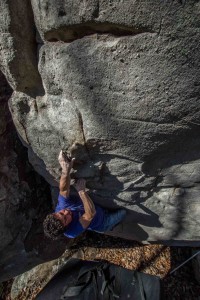
Corey Harris on Rite of Passage (V2)
The Pot Point bouldering area is one of the best kept secrets of the Chattanooga bouldering scene. Potential for new lines and free camping all within a peaceful setting make this spot perfect for climbers looking for something new.
This area sits on the ridge overlooking the river gorge and Raccoon Mountain and is situated along the Pot Point hiking trail. While only the best select problems are included in this initial guidebook release the area has an abundance of unclimbed rock and well featured boulders. Divided into several mini areas the boulders are strewn about for almost a mile.
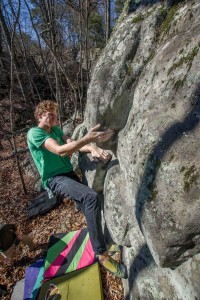
Drew Meyer on Love Handles (V4)
Each area has its classics and warmups with the furthest of all the areas being a large maze of rock, otherwise known as the Fortress. While most visitors to the area will hit the Fortress; the other areas hold enough quality problems to keep all but the strongest climbers busy. Keep in mind that since development in 2006 nature has reclaimed some boulders and problems can grow with lichen again and their approach trails become non-existent. This is part of the beauty of the area so embrace it.
Location:
From the downtown Chattanooga area head north on Hwy 27 taking the Signal Mtn Rd Exit and head west (toward the mountain) taking a left onto TN-27 W/Suck Creek Rd. Drive 8 miles through the scenic Suck Creek area and turning left on to Choctaw Trail following signage for Prentice Cooper. A left turn onto Game Reserve Rd leads you to the entrance of the Prentice Cooper area. Drive 8 miles to the left turn to the Davis Pond Rd. and park here if the roads are closed.
The roads are closed from December to March or in exceptionally wet times. When the roads are open you can drive the loop just past the pond taking the right fork. You will be able to see the Alpha area from the road.
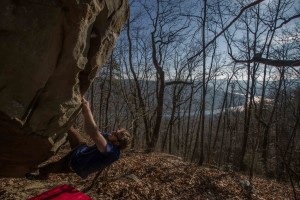
Graham Hodge on Napolean Dynamite (V2/3)
by todd | Jun 4, 2015 | World's Best Rock Climbing Areas
Buy
Trout Creek Climbing here and save money versus purchasing from within our app via Apple or Google. It’s exactly the same guidebook, but offered at a lower price on
rakkup.com.
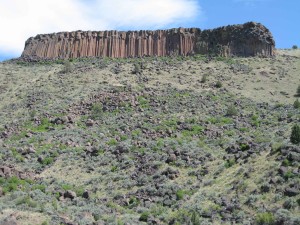
Trout Creek Main Wall as seen from the Deschutes.
In 2001, my dad and I were fishing a part of the Lower Deschutes we had never visited, the blue ribbon section of water from Warm Springs to Trout Creek. There were reports of record numbers of steelhead in the river and the uncharacteristically cloudy weather made chances better than normal for getting lucky. And I was feeling lucky, it was my birthday.
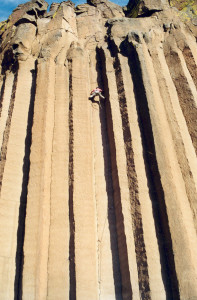
Jeff Wenger on The Space Between (5.10+)
About halfway through the day I landed my first steelhead on a fly rod. It was an awesome battle and after it ended I remember sitting back against the riverbank watching the low clouds swirl and recede upstream to the southwest. The scene changed dramatically as the skies started to clear. Suddenly everything was bright, the sun glaring of off the water almost blinding. I rifled through my pack and eventually located my sunglasses. When I looked back up the entire sky was blue and mirrored in the crystal waters, up the hillside in front of me, was a cliff line of golden columns glowing in the afternoon sun. A couple days later I hiked up to the cliff and climbed what later became known as The Space Between. That lucky birthday led to one steelhead dinner and, in the years since, countless servings of humble pie.
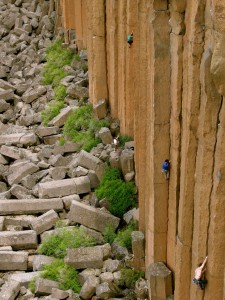
Climbers on the Main Wall.
A little fishing around Central Oregon revealed some knowledge of the place by Smith Rock’s old guard and limited activity on the obvious west-facing wall. After getting the go-ahead from the early visitors I could track down, I replaced the half a dozen or so aging ¼ inch bolts and faded webbing anchors left behind in the 80’s and started picking away at the obvious plums with my brother and a few friends. A year later there were 20 climbs added to the mix. Today Trout Creek offers visiting climbers over 130 routes with most classics ranging from 5.10 – 5.13. All popular routes are equipped with chain anchors and steel lowering carabineers for safety and convenience. Most of the climbing is straightforward with excellent protection and for many years, almost all of the development was done on-sight. In fact, classics were being sent first try even as late as 2008 when Will Stanhope casually dropped in and added Winter Sustenance and Full Clip one empty April afternoon.
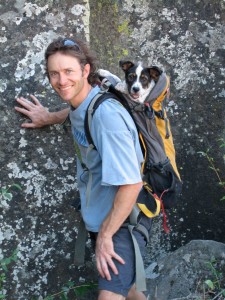
Muddy hitches a ride.
For the decade or so after first spotting the cliff, Trout Creek became my second home. I had my first date with Casey (now my wife) at the crag, we practically raised our dogs at the area. When the youngest, Muddy, was still too little to climb the hill, we carried him up in a pack. To this day Muddy is best behaved and seems most content hanging at one of his perches along the Main Wall.
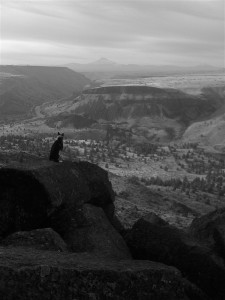
Muddy taking in the view.
Over the years, the beautiful position of the crag seemed to have a similar effect on more and more people. A small community of climbers grew into a large family. We egged each other on at the crag and later during nighttime One Armed Weasel bouldering sessions, we maintained a community bucket filled with information and safety items, we spotted cougars on the way to the cliff and sometimes in the campground, we had icy swimming challenges, trundled giant chunks of columns, and rolled the ”cube” around the fire, we sketched across snow covered columns, organized trail building parties, had run-ins with snakes, poison oak, ticks, black widows in outhouses, even animal traps by the river. Along the way we developed working relationships with landowners, camp hosts, hunters, fishermen, boy scouts, cavers (yes, cavers), Fish and Game officers, local newspaper reporters, trail building specialists, Oregon Field Guide staff, the Madras police department and most critically to the area’s future, with wildlife biologists and policy makers at the BLM.
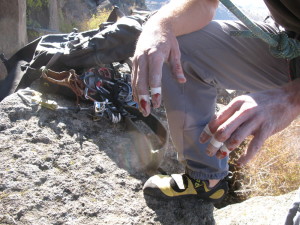
Trout Creek can be tough on the skin.
What could have resulted in a blanket closure of the area due to several Golden Eagle nests located between the SW corner of the Main Wall and Cool Wall evolved into a cooperative effort. Representing climbers at the table with the BLM, our mission was simple: To ensure the safety of the Golden Eagle while advocating for climbers’ rights as a responsible user group. In a show of good faith, and a test of community follow-through, the first seasonal closure in 2012 was voluntary. It was 100% successful in terms of climber compliance. This made a HUGE and positive difference for moving forward in talks with the BLM. Additionally, support from the Access Fund, The Crag Law Center, The American Alpine Club, and letters from many a climber led to a policy that should be sustainable so long as climbers continue to honor the following closure: January 15th – August 15th (This closure includes hiking on the hillsides) If the Golden Eagles do not have a viable nest in the area by May 14th, the area will open to user groups on May 15th.
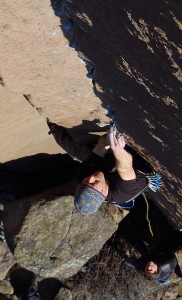
Jeff Wenger on Reservation Blues (5.12+)
So far, climbers have adhered to the seasonal closure but if that changes the area could face permanent closure. Bottom line: Follow the rules and protect future access. More importantly, follow the rules and protect Golden Eagles and the territories they staked out long before any of us came along to go rock climbing.
The impact of climbers, even when the area is empty for part of each year, can be significant. There are no facilities at the cliff. If you need to relieve yourself, please do so in minimally impactful ways and search out an area away from gathering points or the cliff. Also, left over tape, chalk, beer caps, cigarette butts, or other items not really considered garbage in many parts of the world are, in fact, garbage. Please do the right thing(s) in terms of impact and encourage others too also. Together we can all protect the experience and the environment out at Trout Creek.
See you up there,
Jeff Wenger
by todd | Apr 24, 2015 | Uncategorized, World's Best Rock Climbing Areas
Buy
Foster Falls here and save money versus purchasing from within our app via Apple or Google. It’s exactly the same guidebook, but offered at a lower price on
rakkup.com.
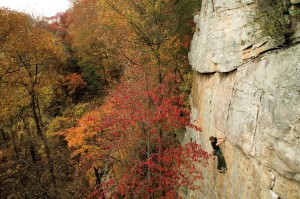
Jason Reynolds on Atrophy (5.11b)
Some of the earliest Foster Falls rock climbing activity dates back to the mid-80s to a handful of now forgotten or retrobolted routes established by a crew of traditional climbers including Chattanooga locals and visiting climbers like Rob Robinson, Steve Goins, and Hidetaka Suzuki. Limited by the amount of ground-up features and paths present within the largely overhung and blocky cliff, these climbers soon moved on to cliffs more palatable to their preferred style.
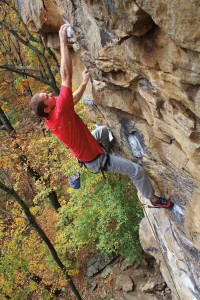
Jay Perry on Thieves (5.12a)
This fact left Foster Falls wide open for the wide-scale sport climbing development that was soon to follow in the early 90s. Led by the efforts of Eddie Whittemore, a bulk of the hardest and best routes at Fosters quickly fell to a committed group of climbers including Southern notables like Doug Reed, Porter Jarrard, and Chris Chestnutt. Other climbers like Paul Sloan, Steve Deweese, Louie Rumanes, and Chris Watford added to the route inventory throughout the mid-90s, while hardmen like Jerry Roberts established new high-end lines in the steep Bunkers.
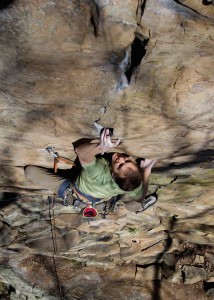
Mike Moore on Super Saturated (5.10c)
Meanwhile, the largely unsung hero of Foster Falls moderates, Steve Jones, began bolting some of the most popular routes at Fosters dating back to the early days of development and continued to do so right up until the recent past. His efforts have led to the growing popularity of far-end moderate walls that are still being filled out by Nashville locals like Mike Moore and Darryl Bornhop. With the exception of a few obscure areas, the walls at Foster Falls are largely tapped out and are home to some of the most well-traveled and well-loved routes in the Chattanooga region. Of special note, with the help of the Southeastern Climbers Coalition, the cliff we climb on (once privately owned), has been secured and turned over to be managed by the South Cumberland State Park guaranteeing future access to this valuable climbing resource.
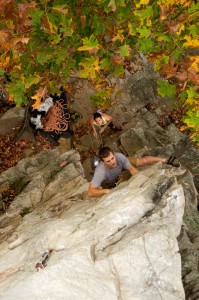
Richard Parks on Bear Mountain Picnic (5.8)
Foster Falls rock climbing is located in the hills of Jasper Tn, After leaving I-24, go north on 28 and get off at the Jasper exit (sign for Foster Falls), and head left off the exit ramp onto Main Street (West 72). After passing through the town of Jasper, take a right at signs reading TN150/US41 north toward Tracy City. Stay on TN150/ US41 North as it splits left and heads up the mountain. The entrance to Foster Falls (marked by a sign) is on your left 6.5 miles up the mountain from this split.
by todd | Apr 22, 2015 | World's Best Bouldering Areas
Buy Norm & Matt’s
Powerlinez guidebook here and save money versus purchasing from within our app via Apple or Google. It’s exactly the same guidebook, but offered at a lower price on
rakkup.com.
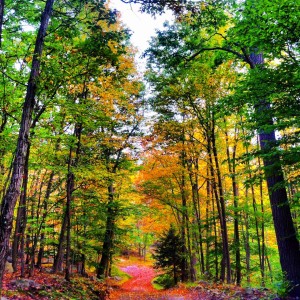
Jeep Trail – Trail Head Entrance
If you are one who is interested in history, then the Powerlinez might be just the place for you. Let me forewarn you – it’s not a place for solitude or escape from the influence of man. Hundreds of years ago, before power plants and landfills, the local Ramapough Indians roamed these hills and especially the Torne Valley region, which is the same valley we climb in today. Rumors of artifacts and old settlements have dated as far back as we remember.
Now, Powerlinez rock climbing is the beginning of a new history. It is the first area in Harriman State Park to be legally opened to climbing. Thanks to all the hard work of the Torne Valley Climbers’ Coalition (TVCC) in 2013; they worked together with the Palisades Interstate Parks Commission (PIPC) to work out a no fee, waiver agreement to get climbers into the area and doing what they love most!
The question is – how long have climbers been climbing here and what history are current climbers going to leave behind?
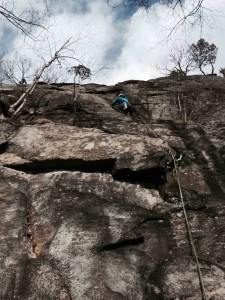
Krista on Goldilocks (5.6)
Over the last two years, development has exploded in the Powerlinez climbing area. There used to be a total of 100-200 boulder problems and roped routes, and now the first release of the rakkup guidebook “Powerlinez” is poised to have 100+ climbs alone. We’re barely exposing a quarter of the total current routes! When the hardest climbs used to top out at 5.10 or V4, local hard climbers are slaying 5.12s and V9s every month. This summer, during our two year anniversary, is only going to rein in more hard and bold climbing.
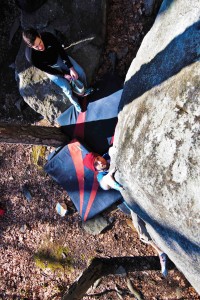
Matt on Indulge the Bulge (V7)
This development has spread as whispers around the local climbing gyms, and a couple local Gunks’ celebrities – Russ Klune and Al Diamond – showed us some hard boulder problems that they messed around on in the 90s. When we thought we were getting first ascents, we realized that we still live in the shadows of the true masters of their craft.
How can you not expect routes to be climbed in an area that’s only an hour away from New York City? With so many people, it’s no surprise that a climber or two have wandered through the boulder fields of the Powerlinez. After all, Storm King Mountain was one of the first rock climbing spots in the Northeast in the 1920s, and that’s still another half-hour north of the Powerlinez.
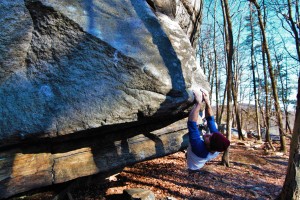
Matt on Indulge The Bulge (V7)
So here we stand, a group of local climbers fielding the interest of an even larger community further south in the metropolis of the city. They all want a taste of local climbing, but what can happen to an area with a new guidebook? Thanks to rakkup, we’re sure that amazing things will happen. With an interactive trail map to stay on the right trail, and waypoints so that you don’t get lost, rakkup is helping climber’s not only follow the rules, but make the most of their climbing experience.
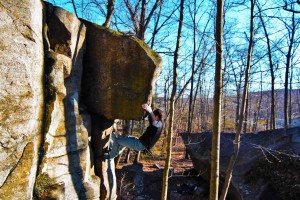
Charlie on Ricochet (V4)
Here’s what we hope: We hope harder climbers will come out and project new stuff. We hope more 5 star problems will become uncovered from their mossy crags by all these climbers. We hope that there will be a responsible stewardship of the area; leaving a legacy of respect for the area, its history, and the locals.
We know that this is the beginning of a long and beautiful history between climbers and state lands. While we look forward to the next hand hold to climb on, may we all remember where we came from, and as more areas open up in New York State Parks, I hope we can remember the little area that started it all. The little yeast that leavened the whole dough: The Powerlinez.
by todd | Apr 13, 2015 | World's Best Bouldering Areas
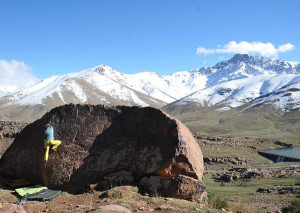
Tijl Smitz on Wind of Dawn (V4)
In the clouds of the High Atlas Mountains in Morocco rests a real bouldering treasure hidden from the climbing community for many years. Oukaimeden is the first bouldering destination in Morocco, and is just a one and a half hour drive from the cultural heart of Marrakech. Bouldering in Oukaimeden combines well with a road trip through Morocco or a city trip to Marrakech and is a cultural and exotic experience.
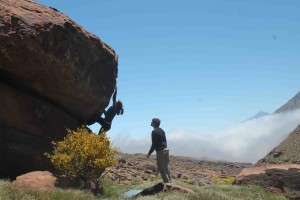
Odielvan Wijkon on Schwartz Walderkirch (V3)
If you thought pioneering was only something done by pioneers in the twentieth century, you are wrong. At 2000 meters above the imperial city of Marrakech you feel the fresh air of nature and splendid views when you get psyched about a new problem you’re working on. Thousands of potential problems are located in the hills surrounding the little village of Oukaimeden. A true pioneer’s experience of exploring new boulders and sending new problems no one has attempted before you.
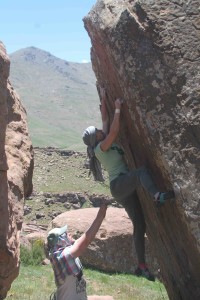
Irene Pieper on Lost Hold (V3)
Oukaimeden is best visited in the spring months of March, through May and during the Autumn months of October and November. The summer months June, July and August can be hot and the mountains are, by then, covered with shepherds. The winter months December through February can be perfect for sending hard problems but at the same time can be frustrating with thick layers of snow. Nevertheless, the sun is strong enough to melt the snow from the boulders, even during the winter months, at a fast pace.
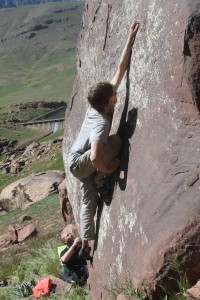
Leander Rutten balancing in The Bakery
Currently, Oukaimeden has three main areas where most of the problems are located. The lowest (2300m.) area, and probably the most flat one too, is called The Colony. A small area with a high density of documented boulders from balancy plates to high balls and seriously overhang cave problems. The Colony is a 7 km drive from the village and is located in a hairpin turn and provides spectacular views over the lush Ourika valley.
The most developed areas are The Bakery & Rivers of Babylon located near the small village of Oukaimeden. At the northwest side of the road The Bakery is covered with the most problems ranging from v0 to v6. There are also potential hard highball problems in this area. Rivers of Babylon is at the north east side of the river and is a long stretched area at Atlas crest line. Don’t wait, book your ticket to Marrakech today and go send these tasty problems.
































